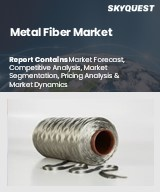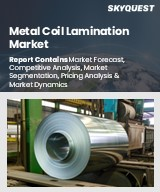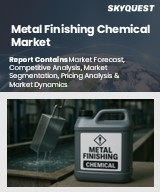
|
시장보고서
상품코드
1410164
세계의 금속 양극 산화 시장 : 예측(2023-2028년)Metal Anodizing Market - Forecasts from 2023 to 2028 |
||||||
금속 양극 산화(Metal Anodizing) 시장은 2021년에 8억 677만 8,000달러로 평가되었으며, CAGR 5.26%로 추이하며 성장 할 것으로 예상되며, 2028년까지는 11억 5,489만 9,000달러에 달할 것으로 예측됩니다.
다양한 산업에서 알루미늄 수요가 증가함에 따라 금속 양극 산화 시장 규모가 확대되고 있습니다. 또한 시장 확대는 마그네슘 합금 및 아연 합금의 사용 증가와 관련이 있을 수 있습니다. 금속 양극 산화 시장은 높은 내구성, 내마모성, 내식성 등 요인으로 인해 확대되고 있습니다. 또한 금속 양극 산화은 여러 가지 장점이 있음에도 불구하고 서비스 및 초기 마감 비용이 상당히 낮습니다. 황산 양극 산화, 하드 양극 산화, 엔드 크롬 양극 산화은 모두 금속 양극 산화 공정의 한 유형입니다. 알루미늄, 마그네슘, 티타늄, 아연 및 기타 금속을 모두 양극 산화 처리하여 다양한 제품을 만들 수 있습니다.
가볍고 내식성이 우수한 부품에 대한 수요 증가
다양한 산업 분야에서 사용이 확대됨에 따라 금속 양극 산화 시장에서 경량 및 부식 방지 부품에 대한 수요가 증가하고 있습니다. 이러한 부품은 가벼운 특성, 내구성 및 경제성 덕분에 자동차, 의료, 항공우주, 전자 등 다양한 산업에서 사용하기에 적합합니다. 부식 방지 부품이 필요한 기업에게 효과적인 선택은 금속 표면에 부식과 마모에 강한 산화물 코팅을 추가하는 양극 산화입니다.
알루마이트 가공이 최고 점유율
알루미늄 부품의 손상, 녹, 내마모성을 강화하기 위한 대표적인 금속 표면 처리 방법은 양극 산화입니다. 전해액에 용해된 금속에 전기를 가하면 금속 표면에 산화층이 생성됩니다. 양극산화 처리된 알루미늄은 더 강하고, 더 탄력적이며, 더 매력적입니다. 가장 견고한 표면 처리 중 하나로, 미적 특성을 개선하고 부식을 방지하며 긁힘에 강하고 스크래치에 강합니다. 건설 업계에서 가장 많이 사용되는 소재 중 하나는 양극산화 처리된 알루미늄입니다. 양극산화 처리된 부품은 자동차 부품뿐만 아니라 문, 욕실 비품, 지붕, 창문, 구조물의 내부 및 외부 마감재 제작에 널리 사용됩니다.
자동차 부문에서 높은 수요
전 세계 금속 양극 산화 시장을 주도하는 주요 산업 중 하나는 자동차 부문으로, 제품의 기능, 매력, 수명을 높이기 위해 양극 산화 부품을 필요로 합니다. 자동차 부문에서 양극 산화은 부식과 마모로부터 부품을 보호하고, 미관을 개선하며, 무게를 줄이는 데 사용됩니다. 더 빠르고 부드러운 승차감을 제공하기 때문에 양극 산화 처리된 자동차 부품은 자동차의 성능을 향상시키는 데도 활용됩니다. 자동차 부문에서 양극 산화 부품에 대한 수요가 증가함에 따라 금속 양극 산화 시장이 확대되고 있습니다.
화성 피막에 대한 요구 증가
화성 피막이라고 불리는 전기 화학적 기술은 화학 물질을 증착하여 금속 부품의 표면 특성을 변화시킵니다. 정교한 화학 공정을 통해 금속에 얇은 코팅이 생성되어 부식에 강해집니다. 금속 가공품의 전반적인 품질을 향상시킬 뿐만 아니라 극심한 열과 습도에 노출된 금속 표면의 부식을 방지합니다. 화학 변환 코팅은 내식성을 높이고 분말 코팅 또는 페인트 접착을 위한 균일한 불활성 표면을 제공합니다. 이러한 코팅은 브러싱, 스프레이 또는 화학 탱크나 욕조에 담그는 방식으로 적용되며, 이는 금속 양극 산화 시장을 주도할 것입니다.
북미가 금속 양극 산화 시장을 독점할 것으로 예측
예상 기간 동안 북미 지역은 금속 양극 산화 시장을 주도 할 것으로 예상됩니다. 이는 항공 우주, 자동차 및 의료 기기 산업에서 금속 양극 산화 서비스에 대한 수요가 증가했기 때문입니다. 또한 이 지역에는 경쟁력 있는 가격으로 최고 수준의 서비스를 제공하는 금속 양극 산화 업체가 상당수 있습니다. 전 세계 자동차, 항공기 및 의료 기기 산업의 상당 부분이 미국에 기반을 두고 있습니다. 또한 미국에는 합리적인 가격의 고품질 서비스를 제공하는 수많은 금속 양극 산화 업체가 있습니다. 또한 캐나다 정부는 금속 양극 산화 산업의 성장을 장려하기 위해 다양한 인센티브를 시행하고 있습니다.
원재료의 고비용
금속 양극 산화 시장 규모를 제한하는 주된 이유 중 하나는 원료의 높은 비용입니다. 금속 양극 산화 공정에는 원료가 필수적이기 때문에 원료의 가격은 생산 비용 및 완제품 가격 모두에 영향을 미칩니다. 그 결과, 금속 양극 산화 공정 전체의 비용이 대폭 상승하여 시장 확대가 제한됩니다.
기술적 진보의 부족
금속 양극 산화 공정의 효율적이고 효과적인 작동은 기술적인 획기적인 변화에 달려 있습니다. 그러나 금속 양극 산화 시장에서 중요한 시장 개척 억제 요인은 기술 진보의 부족입니다. 금속 양극 산화 시장은 기술 진보의 부족으로 인해이 부문의 최근 진보의 혜택을 누릴 수 없습니다. 그 결 및 생산 비용이 상승하고 제품 품질이 저하됩니다.
시장의 주요 출시
2022년 3월, 3.3kV 실리콘 카바이드(SiC) 파워 디바이스의 도입이 Microchip Technology에서 발표되었습니다. 이 가젯은 가볍고 작고 효율적인 전력 솔루션을 제공하므로 전기 수송, 재생 가능 에너지, 항공 및 기타 산업 용도에 유용합니다. Microchip의 3.3kV SiC 전원에는 최대 전류 제한 90A의 SBD와 이 부문에서 최소 RDS(on) 25mΩ MOSFET이 포함됩니다. SBD와 MOSFET은 패키지 또는 다이 형태로 제공됩니다. 이러한 성능 수준의 향상으로 설계자는 작업을 효율화하고, 보다 강력한 시스템을 구축하고, 적은 병렬 부품을 활용하여 보다 작고 가볍고 효과적인 전력 솔루션을 실현할 수 있습니다. 2022년 1월 미국 알루미늄 협회는 '자동차 알루미늄 2022'라는 제목의 새로운 기술 로드맵을 발표했습니다. 알루미늄 공급업체, 재활용업체, 자동차 제조업체, 의사 결정자, 비정부기구 및 기타 업계 이해관계자들은 2022년 자동차용 알루미늄 기술 로드맵에서 향후 10년간 혁신을 촉진하기 위한 주요 협력 경로와 우선순위 기회를 확인했습니다.
목차
제1장 서론
- 시장 개요
- 시장 정의
- 조사 범위
- 시장 세분화
- 통화
- 전제 조건
- 기준연도 및 예측연도의 타임라인
제2장 조사 방법
- 조사 데이터
- 전제 조건
제3장 주요 요약
- 조사 하이라이트
제4장 시장 역학
- 시장 성장 촉진 요인
- 시장 성장 억제 요인
- Porter's Five Forces 분석
- 산업 밸류체인 분석
제5장 금속 양극 산화 시장 : 유형별
- 소개
- 알루미늄 양극 산화 처리
- 티타늄 양극 산화 처리
- 마그네슘 양극 산화 처리
- 아연 양극 산화 처리
- 기타
제6장 금속 양극 산화 시장 : 처리별
- 소개
- 황산 양극 산화 처리
- 크롬산 양극 산화 처리
- 인산 양극 산화 처리
- 붕산·황산 양극 산화 처리
제7장 금속 양극 산화 시장 : 용도별
- 소개
- 항공우주
- 건물
- 컴퓨터 하드웨어
- 자동차
- 일렉트로닉스
- 의학
- 해양
- 기타
제8장 금속 양극 산화 시장 : 지역별
- 소개
- 북미
- 미국
- 캐나다
- 멕시코
- 남미
- 브라질
- 아르헨티나
- 기타
- 유럽
- 독일
- 프랑스
- 영국
- 스페인
- 기타
- 중동 및 아프리카
- 사우디아라비아
- 아랍에미리트(UAE)
- 이스라엘
- 기타
- 아시아 태평양
- 중국
- 일본
- 인도
- 한국
- 인도네시아
- 대만
- 기타
제9장 경쟁 환경 및 분석
- 주요 기업 및 전략 분석
- 스타트업 및 시장수익성
- 합병, 인수, 합의 및 협업
- 벤더 경쟁력 매트릭스
제10장 기업 개요
- Jabil Circuit
- AAC Technologies
- SINCOO
- Chicago Anodizing
- INCERTEC
- Alpha Metal Finishing
- Saporito Finishing
- Hillock Anodizing
- McNichols Polishing&Anodizing
- Archway Anodize
The metal anodizing market was evaluated at US$806.778 million in 2021 and will grow at a CAGR of 5.26% to be worth US$1,154.899 million by 2028.
The growing demand for aluminium in a range of industries is increasing the metal anodizing market size. The expansion of the market may also be connected to the increasing use of magnesium and zinc alloys. The Global Metal Anodizing Market is expanding due to factors such as high durability, wear resistance, and corrosion resistance. Additionally, despite offering a number of advantages, metal anodizing servicing and initial finishing costs are quite low. Sulfuric acid anodizing, hard anodizing, and end chrome anodizing are all types of metal anodizing processes. Aluminium, magnesium, titanium, zinc, and other metals can all be anodized to create various products.
Rising demand for lightweight and corrosion-resistant components
Due to their expanding use in a wide range of industries, lightweight and anti-corrosion components are in higher demand in the metal anodizing market. These parts are recommended for usage in a variety of industries, such as automotive, medical, aerospace, and electronics, thanks to their lightweight qualities, durability, and affordability. An effective choice for companies that need corrosion-resistant components is anodizing, which entails adding an oxide coating to the surface of a metal that is resistant to corrosion and wear and tear.
Aluminium anodizing holds the highest market share
In order to strengthen the damage, rust, and abrasion resistance of aluminium components, anodizing is a typical method of metal surface treatment. By applying electricity to a metal dissolved in an electrolytic solution, an oxide layer is created on the metal's surface. Aluminium that has been anodized is stronger, more resilient, and more appealing. One of the toughest surface treatments available, it improves aesthetic attributes, guards against corrosion, resists scratching, and is scratch-resistant. One of the most often utilised materials in the construction industry is anodized aluminium. Anodized components are widely employed in the construction of car parts as well as doors, bathroom fixtures, roofing, windows, and interior and external finishes for structures.
High demand in the automotive sector
One of the main industries driving the worldwide metal anodizing market is the automotive sector, which needs anodized components to increase the functionality, appeal, and longevity of its goods. In the automobile sector, anodizing is used to protect parts from corrosion and wear and tear, improve aesthetics, and shed weight. Because they provide a faster and smoother ride, anodized automotive components are also utilised to increase the performance of automobiles. The metal anodizing market is expanding as a result of the rising demand for anodized components in the automotive sector.
Increasing need for chemical conversion coating
An electrochemical technique called chemical conversion coating changes a metal component's surface properties by depositing chemicals there. A thin coating is created on metal using a sophisticated chemical process, making it corrosion-resistant. Along with increasing the overall quality of metalwork, it also prevents corrosion on metal surfaces exposed to extreme heat and humidity. Increased corrosion resistance and a homogenous, inert surface for powdered coating or paint adhesion are provided by chemical conversion coatings. They are often applied by brushing, spraying, or submerging in a chemical tank or bath., which will in turn drive the Metal anodizing market.
North America is projected to dominate the Metal anodizing market
During the projected period, the North American region is anticipated to lead the Metal anodizing market. This is due to the increased demand for metal anodizing services in the aerospace, automotive, and medical device industries. Additionally, the area is home to a sizable number of metal anodizing businesses that offer top-notch services at competitive prices. A significant portion of the world's auto, aircraft, and medical device industries are based in the US. Additionally, there are numerous metal anodizing businesses in the US that offer affordable, high-quality services. Moreover, the Canadian government has also implemented a number of incentives to encourage the growth of the metal anodizing industry.
High cost of raw material
One of the main reasons limiting the metal anodizing market size is the high cost of raw materials. Since raw materials are essential to the metal anodizing process, the price of raw materials has an impact on both the cost of production and the price of finished goods. As a result, the entire cost of the metal anodizing procedure rises significantly, which limits market expansion.
Lack of technological advancements
The efficient and effective operation of the metal anodizing process depends on technological breakthroughs. However, a significant development inhibitor in the metal anodizing market is the lack of technological advancement. The metal anodizing market is unable to benefit from recent advancements in the sector due to a lack of technological progress. This results in a rise in production costs and a drop in product quality.
Market key launches
- On March 2022, the introduction of 3.3 kV Silicon Carbide (SiC) power devices was announced by Microchip Technology. These gadgets aid with electric transportation, renewable energy, aviation, and other industrial applications since they are lightweight, tiny, and offer more efficient power solutions. The 3.3 kV SiC power supplies from Microchip includes SBDs with the highest current limit of 90 amps and MOSFETs with the smallest RDS (on) in the field of 25 mOhm. SBDs and MOSFETs can be found in package or die form. These improved performance levels allow designers to streamline their work, build more powerful systems, and utilise fewer paralleled components for more compact, lightweight, and effective power solutions.
- In January 2022, The American Aluminium Association published a new technology roadmap, titled Aluminium for Automotive 2022, including short-, medium-, and long-term R & D goals to serve automotive clients in the aluminium industry. Aluminium suppliers, recyclers, automakers, decision-makers, non-governmental organisations, and other industry stakeholders are identified in the 2022 Aluminium Technology Roadmap for Automotive as major collaborative paths and priority opportunities to promote innovation over the following ten years.
Segmentation:
By Type
- Aluminum Anodizing
- Titanium Anodizing
- Magnesium Anodizing
- Zinc Anodizing
- Others
By Process
- Sulfuric Acid Anodizing
- Chromic Acid Anodizing
- Phosphoric Acid Anodizing
- Boric/Sulfuric Acid Anodizing
By Application
- Aerospace
- Building
- Computer Hardware
- Automotive
- Electronics
- Medical
- Marine
- Others
By Geography
- North America
- United States
- Canada
- Mexico
- South America
- Brazil
- Argentina
- Others
- Europe
- United Kingdom
- Germany
- France
- Spain
- Others
- Middle East and Africa
- Saudi Arabia
- UAE
- Israel
- Others
- Asia Pacific
- China
- Japan
- India
- South Korea
- Indonesia
- Thailand
- Others
TABLE OF CONTENTS
1. INTRODUCTION
- 1.1. Market Overview
- 1.2. Market Definition
- 1.3. Scope of the Study
- 1.4. Market Segmentation
- 1.5. Currency
- 1.6. Assumptions
- 1.7. Base, and Forecast Years Timeline
2. RESEARCH METHODOLOGY
- 2.1. Research Data
- 2.2. Assumptions
3. EXECUTIVE SUMMARY
- 3.1. Research Highlights
4. MARKET DYNAMICS
- 4.1. Market Drivers
- 4.2. Market Restraints
- 4.3. Porter's Five Force Analysis
- 4.3.1. Bargaining Power of Suppliers
- 4.3.2. Bargaining Power of Buyers
- 4.3.3. Threat of New Entrants
- 4.3.4. Threat of Substitutes
- 4.3.5. Competitive Rivalry in the Industry
- 4.4. Industry Value Chain Analysis
5. METAL ANODIZING MARKET, BY TYPE
- 5.1. Introduction
- 5.2. Aluminum Anodizing
- 5.3. Titanium Anodizing
- 5.4. Magnesium Anodizing
- 5.5. Zinc Anodizing
- 5.6. Others
6. METAL ANODIZING MARKET, BY PROCESS
- 6.1. Introduction
- 6.2. Sulfuric Acid Anodizing
- 6.3. Chromic Acid Anodizing
- 6.4. Phosphoric Acid Anodizing
- 6.5. Boric/Sulfuric Acid Anodizing
7. METAL ANODIZING MARKET, BY APPLICATION
- 7.1. Introduction
- 7.2. Aerospace
- 7.3. Building
- 7.4. Computer Hardware
- 7.5. Automotive
- 7.6. Electronics
- 7.7. Medical
- 7.8. Marine
- 7.9. Other
8. METAL ANODIZING MARKET, BY GEOGRAPHY
- 8.1. Introduction
- 8.2. North America
- 8.2.1. USA
- 8.2.2. Canada
- 8.2.3. Mexico
- 8.3. South America
- 8.3.1. Brazil
- 8.3.2. Argentina
- 8.3.3. Others
- 8.4. Europe
- 8.4.1. Germany
- 8.4.2. France
- 8.4.3. United Kingdom
- 8.4.4. Spain
- 8.4.5. Others
- 8.5. Middle East And Africa
- 8.5.1. Saudi Arabia
- 8.5.2. UAE
- 8.5.3. Israel
- 8.5.4. Others
- 8.6. Asia Pacific
- 8.6.1. China
- 8.6.2. Japan
- 8.6.3. India
- 8.6.4. South Korea
- 8.6.5. Indonesia
- 8.6.6. Taiwan
- 8.6.7. Others
9. COMPETITIVE ENVIRONMENT AND ANALYSIS
- 9.1. Major Players and Strategy Analysis
- 9.2. Emerging Players and Market Lucrativeness
- 9.3. Mergers, Acquisitions, Agreements, and Collaborations
- 9.4. Vendor Competitiveness Matrix
10. COMPANY PROFILES
- 10.1. Jabil Circuit
- 10.2. AAC Technologies
- 10.3. SINCOO
- 10.4. Chicago Anodizing
- 10.5. INCERTEC
- 10.6. Alpha Metal Finishing
- 10.7. Saporito Finishing
- 10.8. Hillock Anodizing
- 10.9. McNichols Polishing & Anodizing
- 10.10. Archway Anodize



















